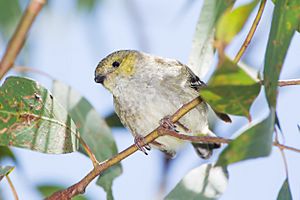Forty-spotted pardalote facts for kids
Quick facts for kids Forty-spotted pardalote |
|
|---|---|
 |
|
| Conservation status | |
| Scientific classification | |
| Genus: |
Pardalotus
|
| Species: |
quadragintus
|
The forty-spotted pardalote (Pardalotus quadragintus) is a very rare bird from Australia. It is one of the rarest birds in the world! You can only find it in the south-east part of Tasmania.
What It Looks Like
This bird is small and full of energy. It is about 9 to 10 centimeters (3.5 to 4 inches) long. The forty-spotted pardalote looks a bit like the more common spotted pardalote.
However, the forty-spot has a dull greenish-brown back and head. Its rump (the area above its tail) is olive green. The feathers under its tail are a dull yellow color. Its chest is white with a light yellow tint.
Its wings are black with white tips. When the wings are folded, these white tips look like many small dots. There are actually closer to 60 dots, not 40! The colors of its feathers stay the same all year. Young birds are just a little less colorful than the adults.
Where It Lives
The forty-spotted pardalote is now found in only a few places. These are isolated groups in south-eastern Tasmania. You can reliably find them on Maria Island and Bruny Island. Sometimes, people report seeing them in the suburbs of Hobart.
This bird does not travel far from its home. It stays in its small area. Sadly, its numbers are going down. It is listed as an endangered species. This means it is at high risk of disappearing forever.
Maria Island is a special place for these birds. It is managed as a safe home for them. Other important places for protecting the forty-spotted pardalote include Bruny Island, Central Flinders Island, Maria Island, and South-east Tasmania. These places are called Important Bird Areas.
Its Home
The forty-spotted pardalote lives in dry eucalypt forests. It especially likes areas with a lot of white gum trees. It finds almost all of its food in these white gum trees.
What It Does
During the time they have babies, forty-spotted pardalotes form pairs. Each pair protects its own area. In winter, they might gather in small groups.
These birds are insect hunters. They carefully search for small insects in the tops of trees. They build their nests inside holes in trees. Sometimes, they even nest in burrows in the ground.
See also
 In Spanish: Pardalote tasmano para niños
In Spanish: Pardalote tasmano para niños



